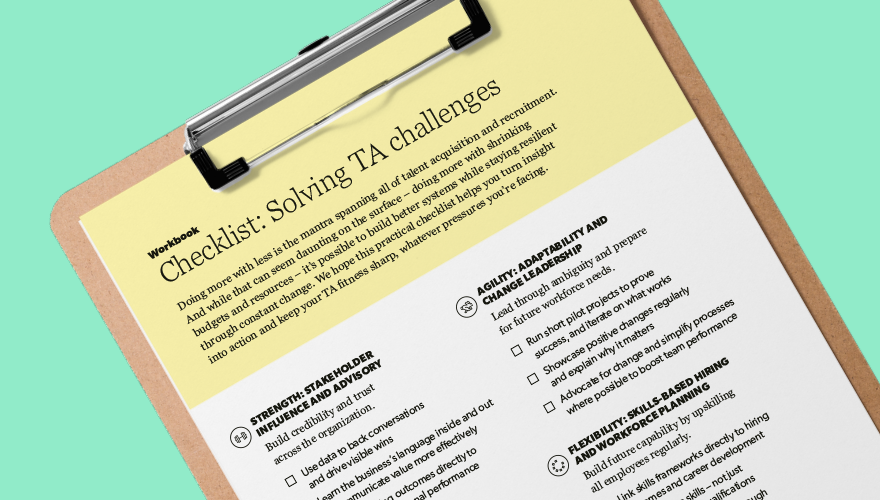Blog
Rethinking talent strategies for long-term success

As businesses navigate a rapidly changing talent landscape, retaining and engaging employees has become more critical than ever. What does it take for organizations to build a resilient, future-ready workforce that thrives in the long-term?
One of the greatest challenges faced by many organizations today is retaining and engaging talent, especially after the COVID-19 pandemic, which sparked the Great Resignation and heightened competition for top talent. Now, companies have an opportunity to create environments where employees feel valued and motivated to stay long-term.
To achieve this, some forward-thinking organizations are reexamining their structure and job design. In high-attrition markets, the instinct may be to immediately replace departing employees. However, it’s important to ask: does this role need to exist in its current form? Can it be made more engaging? Is there a better way to structure the role for greater effectiveness?
While hiring managers often feel the pressure to fill roles quickly, focusing on long-term goals allows businesses to nurture talent for future success. This shift in strategy requires an emphasis on internal growth, learning opportunities, and ensuring managers are equipped to develop their teams.
Promoting internal talent
One effective way to achieve this is by prioritizing internal promotions and career development. Instead of defaulting to external hires, consider assessing your current talent pool to identify potential leaders and offer growth opportunities. This approach not only helps you to fill critical roles, but also fosters a culture of loyalty and engagement.
By rethinking job design and promoting from within, companies can create a more sustainable workforce. While there is often pressure to hire externally, relying too heavily on external candidates risks overlooking the talent you already have within the organization. A balance between external hiring and internal development creates a stronger, more resilient talent pipeline, but it requires a shift in mindset for hiring managers.
Embracing technology
Modernizing through technology is crucial. In many businesses, expertise has historically been tied to individuals rather than systems. By leveraging technology, companies can streamline processes, move certain roles to more cost-effective locations, and make job design more engaging. Automating routine tasks allows employees to focus on more meaningful, intellectually stimulating work, enhancing job satisfaction and aligning with the expectations of the modern workforce.
Millennials, in particular, often seek flexible career paths focused on skill-building rather than traditional job ladders. They value diverse experiences and won’t hesitate to leave a role if it isn’t fulfilling. This creates a challenge for employers: roles must be engaging, with clear career progression, to retain top talent and foster long-term development.
Leadership and employee experience
Effective leadership is crucial for implementing strategies that enhance employee engagement and retention. Managers play a key role in developing their teams, communicating goals, and fostering a culture where employees feel valued. They must embrace responsibilities beyond managing the delivery of tasks by actively contributing to career development and creating growth opportunities for their teams.
By rethinking the traditional employee lifecycle and adopting a more holistic approach to the employee experience, leaders can ensure processes like onboarding and performance reviews are meaningful and impactful. When managers prioritize engagement and development, they help build a stronger, more resilient workforce capable of driving long-term success.
Developing resilience for sustainability
I like to use the analogy of the human body when talking about resilience at work. Just like the human body, ‘work’ operates at varying paces—sometimes sprinting, walking, or enduring marathon-like periods of sustained effort. During these intense phases, focus, efficiency, and the right tools are crucial. Organizations play a major role in supporting employees by ensuring they have the proper equipment and communication channels to work efficiently, both in the office and remotely.
However, maintaining productivity requires a supportive team environment. Remote work, while convenient, can sometimes lead to isolation, reducing collaboration and making it harder for employees to seek help. This can weaken their connection to the company. That's why creating meaningful in-person interactions is vital for team cohesion and stress relief.
Leaders must also ensure that workloads are balanced and manageable. New employees, in particular, shouldn’t be expected to take on high-stakes tasks without proper support. Developing resilience across the organization is essential for maintaining a sustainable workload, helping employees prepare for future challenges.
Shaping a workforce for the future
To build a workforce that thrives in the face of change, it’s essential to have a forward-thinking mindset. It’s about creating environments where employees see a clear path for growth, feel genuinely supported by their leaders, and are empowered by the tools and technology that make their work more meaningful.
By focusing on long-term engagement rather than quick fixes, companies can foster a resilient culture that not only attracts talent but nurtures it, ensuring your organization is equipped for whatever the future holds.
5 tips for building a future-ready workforce
- Reimagine job roles: Instead of automatically replacing departing employees, rethink job design to make roles more engaging and future-focused.
- Promote from within: Identify leadership potential within your current talent pool and offer growth opportunities to foster loyalty and long-term engagement.
- Leverage technology: Automate routine tasks, allowing employees to focus on more meaningful work that makes an impact and aligns with modern workforce expectations.
- Provide clear career pathways: Ensure roles offer diverse experiences and skill-building opportunities to retain top talent, especially millennials seeking growth.
- Support employee resilience: Balance workloads and create a supportive environment, especially during high-demand periods, to help employees thrive and avoid burnout.
Workforce sustainability
Check out more from other thought leaders in our featured content series to help you build a workforce that's resilient, adaptable, and ready to take on the future.












